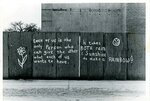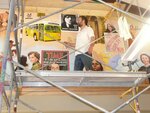



Look up. Look down. Public art, also called vernacular art, is all over Greater Lansing, whether it’s hidden in a bathroom at Harry’s Place or splashed across buildings in Old Town, REO Town and downtown.
No matter where you look, do it soon — it could all disappear in a blink.
Take local artist Dennis Preston’s mural he did for the old Free Spirit store on Washington Avenue in 1969. Gone. Or the mural he did at Eastern High School. It could soon be gone.
Many works of public art are ephemeral. Consider the thousands of rock concert posters Preston has drawn since the 1960s. They’re now collector’s items.
In 1971, I got my own 35-millimeter camera, a Pentax without a meter, and a 135-millimeter lens from a Michigan State University artist, with a lens shield that took a blow from a police baton in Chicago in 1968. I wandered around Lansing figuring out the F-stops and shooting anything I liked.
Over the decades, I’ve photographed public art incessantly. In 1971, I came across graffiti on plywood construction barriers near Lansing Community College’s downtown campus. There was a flower on one side and a smiley face on the other.
The graffiti featured two inspirational messages. The first read: “Each of us is the only person who can give the other what each of us wants to have.” Mirroring that was the second: “It takes BOTH rain & sunshine to make a RAINBOW!”
A couple of years later, when my spouse and I were getting married, we decided to use my photo of the graffiti on our wedding invitation.
As our 50th anniversary approached, I asked local artist Bob Rose to paint that piece of wall art. Since his reference was a black-and-white photo, he used his imagination to recreate the piece in a rainbow of colors.
With more public art popping up each month, it’s difficult to keep up. Some of it was executed decades ago in obscure places like the basements of bars or under bridges. I just discovered a large, pristine mural depicting transportation throughout the ages at Michigan State University’s service garage under Spartan Stadium. It was completed by a former East Lansing High School student in 1986.
MSU buildings are also peppered with adornments by renowned sculptors such as Samuel Cashwan and Corrado Parducci. Some of my favorites are C.L. Schmitz’s reliefs on the old Physics Building, which depict Einstein and other physicists.
Before the COVID-19 pandemic, Steven Bridges, now the interim director of MSU’s Broad Art Museum, and I lectured on public art at the John F. Dye Water Conditioning Plant, which has several stunning works of public art by noted muralists and sculptors, including Cashwan.
Some of the Lansing area’s public art is often taken for granted. For example, the largest collection of public art may be at the end of Michigan Avenue in the state Capitol, which holds hundreds of pieces, including portraits of many Michigan governors. My favorite is the ghostlike painting of former Gov. John Swainson, which appears to be half-finished. He wanted it to represent his career as unfinished.
Two of my favorite places to shoot photos are Old Town and REO Town, where the backs and fronts of buildings are ablaze with public art. One hidden gem is the 1950s artwork in the basement storage area of REACH Studio Art Center, which was installed when the space was still Maria’s bar. I first saw the lusty scenes at fraternity parties in the mid-‘60s.
Speaking of bars, murals of famous and almost-famous MSU and Michigan Agricultural College barflies line the backroom at Coral Gables in East Lansing, still there after being painted 60 years ago by a Lansing resident.
And public art just keeps coming. Work on two murals are scheduled to start today (May 17), one at West Saginaw and Pine streets at the office of The Rathbun Agency, and the other at the Old Town General Store. An additional mural project is expected to begin soon at the new T.A. Forsberg apartment complex on South Washington Avenue. Furthermore, the Lansing Art Gallery, which recently relocated to Knapp’s Centre, is hosting an event at 4 p.m. June 2 that will allow community members to make their mark on ArtPath by assisting two ArtPath muralists, Jessica and Zach Kovan, and contributing their own art to an installment.
You may be wondering why there is so much public art in the Lansing area and why it matters.
In 2004, Cathy Babcock, an art activist and former executive director of the Lansing Art Gallery, brought one of the city’s most influential vernacular art exhibits, “Wheel Art,” to Lansing when the gallery partnered with General Motors Design Center and Downtown Lansing Inc. to have 20 acrylic-molded cars painted and artistically embellished by Michigan artists. The idea was inspired by cities like Chicago, which sponsored public art of cows in its downtown area.
“It was natural for Lansing since we’re a car city,” Babcock said.
She believes putting art on the street made it more accessible.
“One reason public art began to flourish is many people were not comfortable in art galleries,” she said.
She also pointed to the building-sized REO Motors mural that was completed in REO Town as lighting the fuse for public art. It has since been moved to a site across from R.E. Olds Transportation Museum on Museum Drive.
Lansing isn’t alone in recognizing the importance of public art. An app called Let’s Roam allows users to view public art in scores of cities. The idea is to provide context and information about the artists. The Arts Council of Greater Lansing had a similar app at 517artsearch.com, but a recent search for it came up empty.
Let’s Roam is blunt about how Detroit Mayor Mike Duggan saw public art as a negative that needed to be erased. Some may remember the debacle he had with famed graffiti artist Shepard Fairey. While Fairey was working on a commissioned piece in Detroit in 2015, the city charged him with vandalism for allegedly tagging buildings with posters of his art. The charges were later dismissed.
Duggan isn’t the only one who views public art as a nuisance. Not everyone was happy last year when Rose and Preston were joined by 24 other local artists to spiff up gray traffic-signal boxes around Lansing. The art was viewed as graffiti by some community leaders.
However, Rose said he was inspired by how engaged folks were with his art, asking questions and making thoughtful comments. He was blown away when a man from Kathmandu, Nepal, introduced himself, and a couple of students from India wanted to have their picture taken with the art.
“That art from Lansing is out there flying around the world,” Rose said.
In the last 12 years, the Lansing Economic Area Partnership has sponsored 35 public art projects in the tri-county area and invested $350,000 in the Public Art for Communities Grant Program.
Bob Trezise, LEAP’s president and CEO, said, “Public art is an effective way of showing we are a culturally creative community, and it also signals we are a sophisticated upscale community, and that attracts economic vitality.”
There’s that, but it’s also just fun to discover and look at.
Support City Pulse - Donate Today!
Comments
No comments on this item Please log in to comment by clicking here